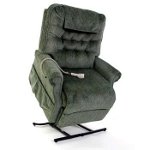Understanding the Modern Lift Chair
Published by Steve Hedberg on July 11, 2009 Under lift chairs
 One of the most common diseases to affect a seniors mobility is arthritis, although there are many other diseases and disorders who also limit a seniors ability to get around. Arthritis, and diseases like it, can make many day to day tasks very difficult and cumbersome to preform. Perhaps one of the most difficult processes for seniors with these types of diseases is that of standing up safely. Since standing and sitting is such a difficult problem for so many seniors, there are a number of companies that manufacture lifting aids to address this problem.
One of the most common diseases to affect a seniors mobility is arthritis, although there are many other diseases and disorders who also limit a seniors ability to get around. Arthritis, and diseases like it, can make many day to day tasks very difficult and cumbersome to preform. Perhaps one of the most difficult processes for seniors with these types of diseases is that of standing up safely. Since standing and sitting is such a difficult problem for so many seniors, there are a number of companies that manufacture lifting aids to address this problem.
Lift Chairs are one of the most common types of lifting aids that are used to address this issue. They are also often called riser recliners, due to the design many of these devices use.
To help understand the modern lift chair, it is first necessary to know a little bit of history about these types of lifting devices.
The First Lift Chairs
Originally, lift chairs were manufactured by taking a regular recliner and adding a lifting spring to the base of the chair. However, this proved to not be a very safe design for lift chairs for two reasons. One was that a regular recliner is not designed to be raised up into the air repeatedly. As a result, over long term use the structure of a regular recliner simply was not strong enough to support the stresses of being raised and lowered constantly.
The other problem presented by the first riser recliner was the lifting system itself, which used springs. These lift chairs fitted a spring lifting system into the base of the chair and the person sitting in it into the air. There are actually several safety concerns associated with a spring lift chair, but the biggest one was that once the lift had been activated, it could not be stopped. This means that if the lift chair was accidentally triggered, such as by accidentally hitting the button or perhaps a pet rubbing up against the spring release, the occupant could be dumped from the lift chair.
Aside from the obvious hazard of unintentionally dumping a senior from the chair, which could result in a serious fall for a senior, the whole lifting process was often jerky and not very fluid. This added a whole other aspect of safety concerns.
Improvements in Lift Chair Design
Due to the numerous safety concerns that were associated with the original riser recliners, change was needed and came in the mid eighties with the development of the electric lift chair. These lift chairs were designed using an electric lift component that was operated using a constant pressure switch. The constant pressure switch ensured that the lift chair only moved while its button was being pressed, eliminating the chance of accidentally being ejected from the lift chair.
It was around this time that some manufactures began custom building the frame of the lift chair. This allowed the manufactures to take into account the stresses the lift chair would be subjected too everyday and design the frame to withstand these stresses. Specifically two companies, Golden Lift Chairs and Pride Lift Chairs, were responsible for the beginning of the movement of a custom built lift chair frame, although others quickly followed.
Today, lift chairs are still manufactured using a similar designs, which include electric lift systems and frames that are specially designed to withstand the stress of being raised and lowered throughout the day. There are many different manufactures of these devices as well, but Pride Lift Chairs and Golden Lift Chairs remain the most popular and well respected in the lift chair industry.
No Comments |